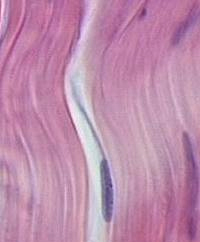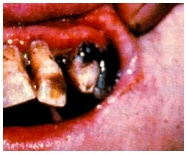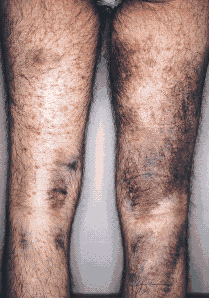 Dense
regular connective tissue (Fig 5-22) is another example of common CT. Dense
regular connective tissue (Fig 5-22) is another example of common CT.
This type gets its name because it
occurs in tendons and ligaments, on the outer surface (“capsule”) of
some large organs or around skeletal structures.
- Identify this tissue type in
slides 75 (adrenal gland),
55 (testis) and
34 (bone).
- One section of the bone on
slide 34 shows a process of fracture repair.
- Examine the more active
fibroblasts in this region, noting their characteristic features
as described in Fig. 5-3.
Sketch the relationship between
fibroblasts and collagen bundles in dense regular connective tissue.
Clinical note: Without an
adequate supply of vitamin C, as in the nutritional deficiency
scurvy, collagen I and II do not polymerize properly, leading to
- Slow wound healing,
- Distension of blood vessels,
- Ease of bruising and
- Loosening of
the teeth and bleeding gums (Murphy)
Now let's find the
cellular constituents we've been
talking about. |
 |
 |
|